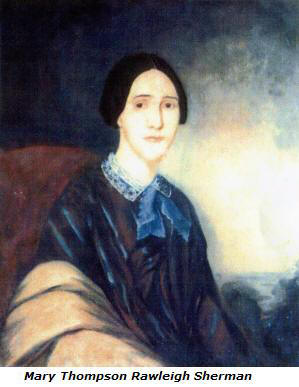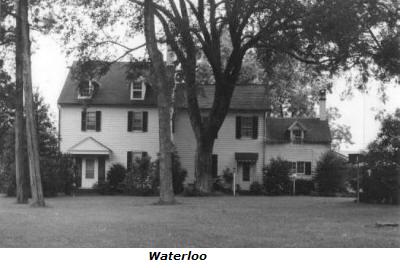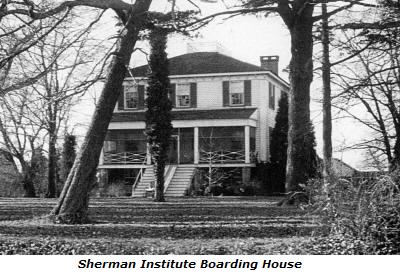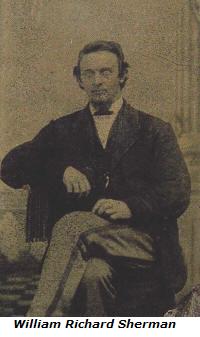East New Market
Notable People and Families
Sherman Family
Thomas Benjamin Sherman and the Sherman Family of East New Market
Thomas Benjamin Sherman was born 7 February 1811. He was the son of Richard Sherman (d. 1819) and Elizabeth Ann Stevens (d. 1839). Richard and Elizabeth Sherman are buried at East New Market Cemetery. Thomas B. Sherman had 3 siblings, Soloman (m. Mary Rue 1829), Sarah (m. Andrew S. Gootee 1825), and Elizabeth "Betsy" Ann (m. Silas Fleming 1831).
On 19 January 1835 Thomas Benjamin Sherman married Mary Thompson Rawleigh. Mary Thompson Rawleigh was born 23 November 1818, the daughter of William Rawleigh (d. 1819) and Mary Thompson (ca1783-1824).
The first appearance of the Sherman family in East New Market was in 1841 when Mary Rawleigh Sherman and her husband, Thomas B. Sherman sold property in New Market. This land was on the north side of the road that was to become Railroad Avenue. Mary Sherman inherited this land from her mother Mary Rawleigh, widow of William Rawleigh. Mary Rawleigh (the mother) purchased this land from her brother-in-law, Greenbury Rawleigh in 1820. Greenbury Rawleigh bought this land in 1815. The Rawleigh family was large and numerous in Dorchester County and the New Market District, but only present in town of New Market from 1815 to 1841.


Thomas B. and Mary Sherman had two sons who survived to adulthood, William Richard Sherman (1835-1908) and Benjamin Walter Sherman (1839-1923). Both sons played a role in the history of the area in and around East New Market. For more information about William and Walter scroll to the bottom of this page. Mary Rawleigh Sherman died just shy of her 25th birthday on 13 November 1842 and is buried at East New Market Cemetery. On October 30, 1843, Thomas B. Sherman remarried to Elizabeth Ann Harrison. Elizabeth Ann Harrison Sherman was born 20 September 1821, the daughter of William Harrison and Mary Jackson.
At the time of the marriage, Elizabeth Ann Harrison Sherman owned two houses and lots in East New Market. She inherited the East New Market property from her parents. Her mother, Mary Jackson was the daughter of Thomas Jackson. Thomas Jackson purchased a vacant lot on the east side of Main Street from James Sulivane in 1796. A house was erected there between 1796 and the 1843. Thomas B. Sherman sold the property in 1872. In 1943, the old 3 room house was moved to the rear of the lot and later torn down (or possibly moved). The lot is now the site of the Mary Titus Webster House. Thomas Jackson also purchased a house and lot from Thomas Stevens in 1801. The old frame house was torn down around 1909, but can be seen on the 1877 Map labeled as Capt. T.B. Sherman on the east side of Main Street. The lot was combined with another and is now the site of the Charles Webster House. Thomas B. Sherman's devised the house to his son William R. Sherman in 1885. William R. Sherman gave the house to his daughter, Minnie Howard in 1896, but he continued to live there even after it was sold to the Webster's in 1900.
In 1848, Thomas B. Sherman patented 44 1/4 acres southwest of East New Market called "Sherman's Beginning". Later that year he resurveyed this tract with two others he owned called "Evan's Chance" and "Ennall's Woodyard", and renamed this 200 acre tract "Sherman's Chance". On this tract, he built or added to a large house known as Waterloo. The house looks out on the Choptank River at Indian Creek. Thomas B. Sherman age 39 was likely living at Waterloo at the time of the 1850 Census. He was listed as a farmer with $16,000 in property and living with his wife Elizabeth Sherman age 29, Mary Stephens age 35, Episcopal Minister Harry J. Windsor age 22, William R. Sherman age 14, Benjamin W Sherman, age 11, and Clement Frazier mulatto, age 50.
Adjoining Waterloo there was a landing known as Sherman's Wharf. In 1860 the Maryland State Legislature passed an act to allow Thomas B. Sherman to build a wharf on the north side of Indian Creek and charge reasonable wharfage fees for the use thereof. He was allowed to extend the wharf far enough into the creek for steamboats and other vessels to enter. The wharf was used for steam shipping between this part of Dorchester County and Baltimore in the second and third quarters of the 19th Century. Thomas B. Sherman was known as Captain Tom. In 1866, Sherman was also one of the commissioners of the Dorchester and Delaware Railroad.

In the 1840s, Captain Sherman founded a school called Sherman's Collegiate Institute. A 1854 advertisement outlining the course of study lists Mathematics and Languages, with the Sciences for $40 per year. Boarding was $110 per year with washing included. The school had a boarding house and a school house. The school house was 2 stories and had a steeple In 1871, Sherman purchased a lot on the west side of Main Street in East New Market. Between 1871 and 1877, Sherman moved the school house to the lot. It was referred to in a deed as the old Sherman Institute building. By the turn of the century, the old Sherman Institute building was used as a barbershop and known as the Red, White, & Blue building. It burned to the ground in the 1914 East New Market Fire. The boarding house part of Sherman's school still stands north of Route 16 near its juncture with Green Point Road.

Elizabeth Ann Harrison Sherman died 31 August 1860. Sherman remained a widower for the remainder of his life. Stories passed down through the Sherman family tell of Thomas B. Sherman being a stern and exacting man. He was devoted to his two sons, but very strict. As each son reached his 18th birthday, he gave each one $5000 and then told them they were on their own and could do as they saw fit. He told them they could invest or squander the money, but they would receive no more from him.
By the time of the 1876 tax assessment, Thomas B. Sherman owned a considerable estate in and around East New Market. He owned Waterloo 200 acres with buildings & improvements, Indian Lots 260 acres with buildings & improvements, Shermans Chance 212 acres with buildings & improvements, Epping's Forest 300 acres with buildings & improvements, a Steam Mill lot, a dwelling house & lot in ENM where Seymour lives 1/2 acre, a dwelling house & lot in ENM where Hamilton lives 1/2 acre, Sherman's Enterprise near Linkwood 188 acres with buildings & improvements, 4 horses, 6 oxen, 5 cows, 18 sheep, 15 hogs, poultry, 1 carriage, 4 carts, Lot F implements, 6 beds, Lot H furniture, Silverware, 1 gold watch, and goods, wares, & merchandise at Sherman's Institute.
Thomas B. Sherman died 7 March 1885. He and his second wife Elizabeth are buried at East New Market Cemetery. A notice in the newspaper reads as follows: Captain Thomas B. Sherman, a well-known farmer and fruit grower of Dorchester County, died at his residence, on the Choptank River, near East New Market, on Saturday morning, aged about 70 years. He had been in feeble health for several years, but the immediate cause of death was the result of injuries received about two weeks ago by accidentally falling into the fire. He was possessed of quite a large landed estate. Captain Sherman leaves two grown sons, Wm. R. Sherman of Baltimore and Walter Sherman of Louisville.
Thomas Benjamin Sherman and Mary Thompson Rawleigh had three sons:
 (1)
William Richard Sherman was born 7 December
1835. He is frequently referred to as Billy in the
Diary
of Emma Edmondson. On 21 December 1858, he married Mary Daniel Colescott. She
was born 30 July 1835, the daughter of Stephen Colescott and Rebecca
Richardson. In 1860 William and Mary Sherman were living in a hotel in
Denton, Maryland. William was working as a Steam Boat Clerk.
William and Mary Sherman moved to Louisville, Kentucky before 1860 and that
is where they had their first daughter Mary Thomas. (1861-1927, m. Thomas
Gaule). Around 1862, they moved to Baltimore where their other four children were born
Gennive Blanch (1863-1864), William Roger (1863-1900, m. Minnie A. Welby), Minnie Gertrude (1865-1914,
m. J. Harry Howard), and Grace Magdalin (1868-1952, m. B.W. Holland).
(1)
William Richard Sherman was born 7 December
1835. He is frequently referred to as Billy in the
Diary
of Emma Edmondson. On 21 December 1858, he married Mary Daniel Colescott. She
was born 30 July 1835, the daughter of Stephen Colescott and Rebecca
Richardson. In 1860 William and Mary Sherman were living in a hotel in
Denton, Maryland. William was working as a Steam Boat Clerk.
William and Mary Sherman moved to Louisville, Kentucky before 1860 and that
is where they had their first daughter Mary Thomas. (1861-1927, m. Thomas
Gaule). Around 1862, they moved to Baltimore where their other four children were born
Gennive Blanch (1863-1864), William Roger (1863-1900, m. Minnie A. Welby), Minnie Gertrude (1865-1914,
m. J. Harry Howard), and Grace Magdalin (1868-1952, m. B.W. Holland).
Census records and city directories place William R. Sherman in Baltimore from 1867 to 1885. From 1867 to 1869, he ran a store with J.M. Murphy called Sherman & Murphy. From 1870 to 1885, he was a clerk and a steam boat agent for the Baltimore, Chesapeake, & Richmond Steamboat Division. Mr. Sherman was also an inventor. In 1880, he patented a Peach Stoner & Parer that resulted in a "Great Saving in Fruit, Labor, and Money". In 1895, he patented a Combination Screw Wrench which had "many other advantages over the ordinary kind".
After his father died in March 1885, William R. Sherman inherited 1/2 interest in several properties in and around East New Market. In 1885 he purchased his brother's 1/2 interest in these properties. The East New Market properties included an old house on the East side of Main Street that was later town down and is now the Charles Webster House, and the original classroom building of the Sherman Institute that was moved to East New Market, but later destroyed in the 1914 fire
After inheriting his father's property, William R. Sherman and his family moved to Sherman's Chance. Sherman's Chance (or Shermantown) is just southwest of East New Market and is where William Richard was raised. William Richard and Mary kept horses, turkeys, chickens, and cows on the farm. One horse named "Dexter" did not like wooden bridges. When he came to one, he would try to jump over it. Glenn Colescott, a young nephew of Mary D. Sherman lived with the Sherman's after his father had died in the late 1880s.
In 1887, William Richard Sherman sold the old Sherman Institute building and the house at 38 Main Street because he was unable to pay a mortgage. He later had to sell the Sherman's Chance property. William Richard Sherman still owned a small frame house on the east side of Main Street in East New Market. He ran a candy store out of the front of the house and he lived in the back. Mary Colescott Sherman died suddenly on 2 April 1894. William Richard died there on 4 July 1908 with very little left of his estate.
Obituary - William Richard Sherman, one of the best known residents of East New Market, died at his home in that place Saturday morning, at six-thirty o'clock, of Bright's disease, aged 73 years. Mr. Sherman was a son of the late Thomas B. Sherman, who was a very large land and slave owner at the time of the Civil War, and who founded the Sherman Institute, and education institution well known at the time that it flourished, and at which were employed some of the best instructors of that day. Mr. Sherman's wife, a Miss Colescott, of Caroline County, to whom he was married in 1859, died about 15 years ago. They were survived by three children, Mrs. Roland Howard and Mrs. B. W. Holland, of Secretary, and Mrs. J. Harry Howard, of East New Market. He also leaves a brother, B.W. Sherman, of near East New Market. The funeral services were held Sunday afternoon at the Catholic Church at Secretary, with interment in the cemetery of that church. Undertaker Howard Willoughby, of East New Market, had charge of the funeral arrangements.
 (2)
Benjamin Walter Sherman was born in 1839 in Dorchester County. In
1860, he was 21 years old, single, and living in Louisville, Kentucky working as
a bookkeeper. In Dorchester County, Maryland on 3 November 1860, Benjamin
Walter Sherman married Margaret A Holland. She was born 27 September 1840.
They couple returned to Louisville and were living there in 1870, where Walter
worked as a Merchant. Walter and Maggie had seven children Anna E (1861-
married Mr. Sharp), Thomas Moss (1864- married Pauline Holland), Walter Raine
(1866- married Minnie Hays), Elizabeth E (1870-), Margaret L. (1872-, married
Louis Maurice, owned Buckland
1913-1943), Ada R.
(1874-married Mr. Hanson), and Howard G. (1877- of Philadelphia 1923).
In 1880, Walter Sherman was operating a feed store in Louisville. After his father died in 1885, he sold his
share of his inherited property in and around East New Market to his brother,
William R. Sherman.
(2)
Benjamin Walter Sherman was born in 1839 in Dorchester County. In
1860, he was 21 years old, single, and living in Louisville, Kentucky working as
a bookkeeper. In Dorchester County, Maryland on 3 November 1860, Benjamin
Walter Sherman married Margaret A Holland. She was born 27 September 1840.
They couple returned to Louisville and were living there in 1870, where Walter
worked as a Merchant. Walter and Maggie had seven children Anna E (1861-
married Mr. Sharp), Thomas Moss (1864- married Pauline Holland), Walter Raine
(1866- married Minnie Hays), Elizabeth E (1870-), Margaret L. (1872-, married
Louis Maurice, owned Buckland
1913-1943), Ada R.
(1874-married Mr. Hanson), and Howard G. (1877- of Philadelphia 1923).
In 1880, Walter Sherman was operating a feed store in Louisville. After his father died in 1885, he sold his
share of his inherited property in and around East New Market to his brother,
William R. Sherman.
Walter Sherman returned to East New Market and in 1909 purchased a house known as the Lida M. Smith House on the north side of Railroad Avenue. He also purchased an adjacent lot to the east in the same year. This property was sold by his heirs after Walter and his wife passed away.
By 1900, Walter and Maggie returned to East New Market and lived the rest of their lives there. Walter died in East New Market on 24 February 1923. Maggie died 7 months later on 23 September 1923. Both are buried at East New Market Cemetery.
(3) Another son of Thomas B. & Mary Sherman was born 28 May 1842 and died 13 October 1842.
Thomas B. Sherman did not have any children by his second
wife, Elizabeth Ann Harrison Sherman.
[Special Thanks to Monica Dise Kelly of Easton, Maryland for providing most of the photos, stories and other materials for the Sherman family.]